A Case Study of Walt Disney: Examining Internal, External Factors
VerifiedAdded on 2023/04/04
|7
|1236
|272
Case Study
AI Summary
This case study provides a comprehensive analysis of The Walt Disney Company, examining the internal and external factors influencing its business operations. It includes a SWOT analysis, highlighting the company's strengths, weaknesses, opportunities, and threats, such as its diversified entertainment portfolio, strong brand reputation, and expansion into emerging markets, alongside challenges like economic unrest and competition. A PEST analysis further explores the political, economic, social, and technological factors impacting Disney, including the effects of international relations, economic stability, social attitudes, and technological advancements in digital media. The study concludes with recommendations for improvement, focusing on leveraging re-innovation, strengthening the amusement park business, and expanding into emerging markets to maintain a competitive edge. Desklib provides students access to this and other solved assignments.
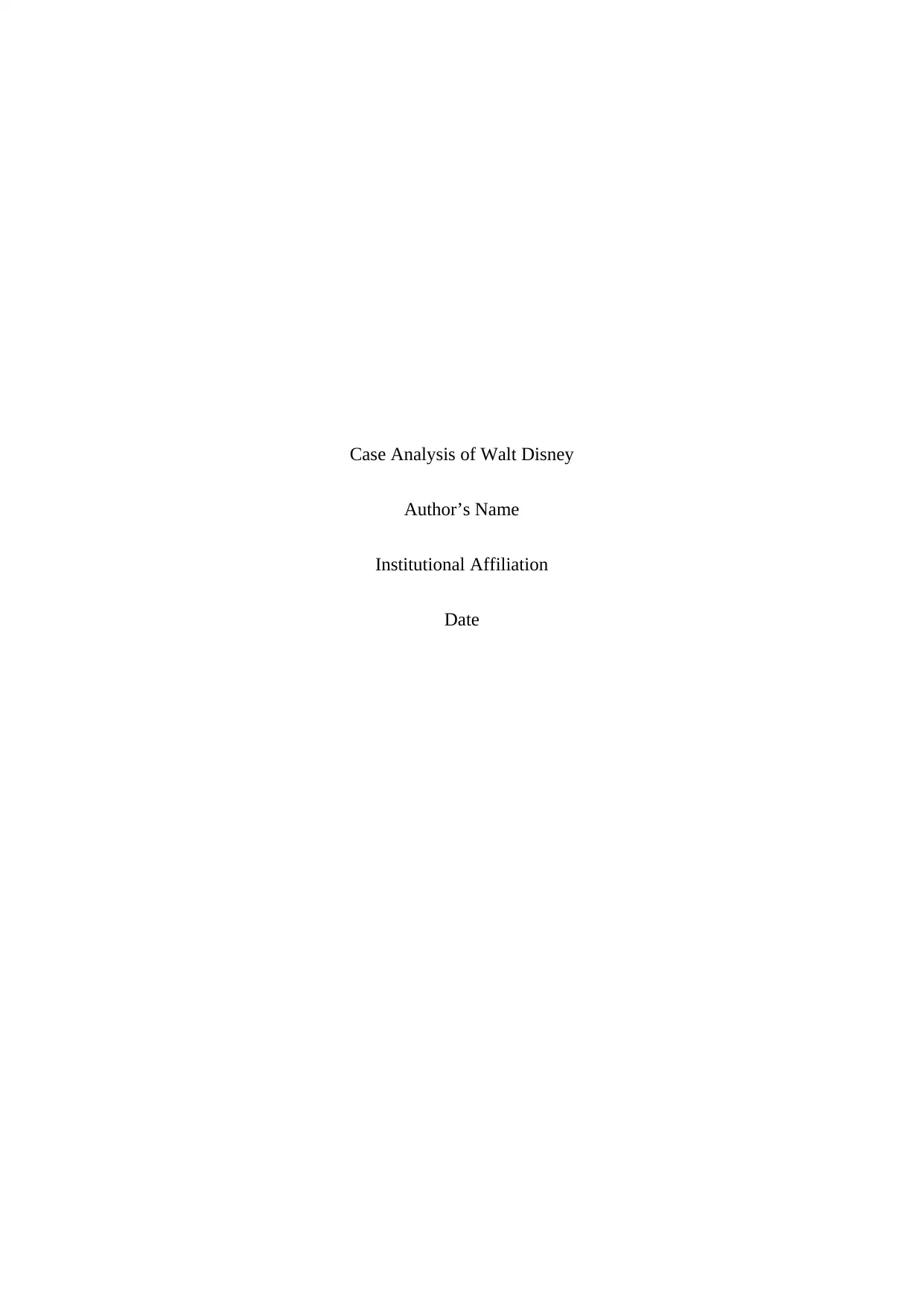
Case Analysis of Walt Disney
Author’s Name
Institutional Affiliation
Date
Author’s Name
Institutional Affiliation
Date
Paraphrase This Document
Need a fresh take? Get an instant paraphrase of this document with our AI Paraphraser
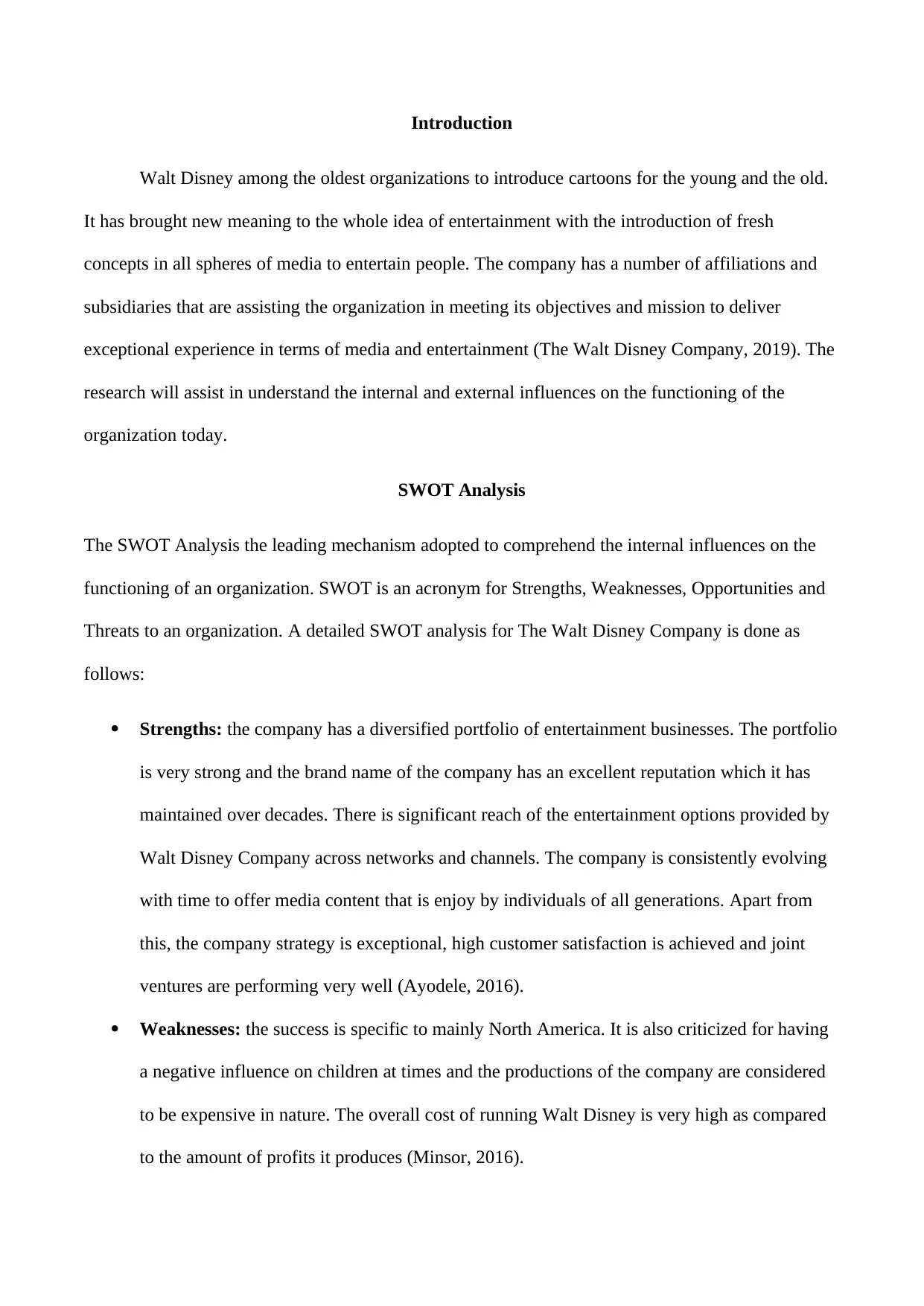
Introduction
Walt Disney among the oldest organizations to introduce cartoons for the young and the old.
It has brought new meaning to the whole idea of entertainment with the introduction of fresh
concepts in all spheres of media to entertain people. The company has a number of affiliations and
subsidiaries that are assisting the organization in meeting its objectives and mission to deliver
exceptional experience in terms of media and entertainment (The Walt Disney Company, 2019). The
research will assist in understand the internal and external influences on the functioning of the
organization today.
SWOT Analysis
The SWOT Analysis the leading mechanism adopted to comprehend the internal influences on the
functioning of an organization. SWOT is an acronym for Strengths, Weaknesses, Opportunities and
Threats to an organization. A detailed SWOT analysis for The Walt Disney Company is done as
follows:
Strengths: the company has a diversified portfolio of entertainment businesses. The portfolio
is very strong and the brand name of the company has an excellent reputation which it has
maintained over decades. There is significant reach of the entertainment options provided by
Walt Disney Company across networks and channels. The company is consistently evolving
with time to offer media content that is enjoy by individuals of all generations. Apart from
this, the company strategy is exceptional, high customer satisfaction is achieved and joint
ventures are performing very well (Ayodele, 2016).
Weaknesses: the success is specific to mainly North America. It is also criticized for having
a negative influence on children at times and the productions of the company are considered
to be expensive in nature. The overall cost of running Walt Disney is very high as compared
to the amount of profits it produces (Minsor, 2016).
Walt Disney among the oldest organizations to introduce cartoons for the young and the old.
It has brought new meaning to the whole idea of entertainment with the introduction of fresh
concepts in all spheres of media to entertain people. The company has a number of affiliations and
subsidiaries that are assisting the organization in meeting its objectives and mission to deliver
exceptional experience in terms of media and entertainment (The Walt Disney Company, 2019). The
research will assist in understand the internal and external influences on the functioning of the
organization today.
SWOT Analysis
The SWOT Analysis the leading mechanism adopted to comprehend the internal influences on the
functioning of an organization. SWOT is an acronym for Strengths, Weaknesses, Opportunities and
Threats to an organization. A detailed SWOT analysis for The Walt Disney Company is done as
follows:
Strengths: the company has a diversified portfolio of entertainment businesses. The portfolio
is very strong and the brand name of the company has an excellent reputation which it has
maintained over decades. There is significant reach of the entertainment options provided by
Walt Disney Company across networks and channels. The company is consistently evolving
with time to offer media content that is enjoy by individuals of all generations. Apart from
this, the company strategy is exceptional, high customer satisfaction is achieved and joint
ventures are performing very well (Ayodele, 2016).
Weaknesses: the success is specific to mainly North America. It is also criticized for having
a negative influence on children at times and the productions of the company are considered
to be expensive in nature. The overall cost of running Walt Disney is very high as compared
to the amount of profits it produces (Minsor, 2016).
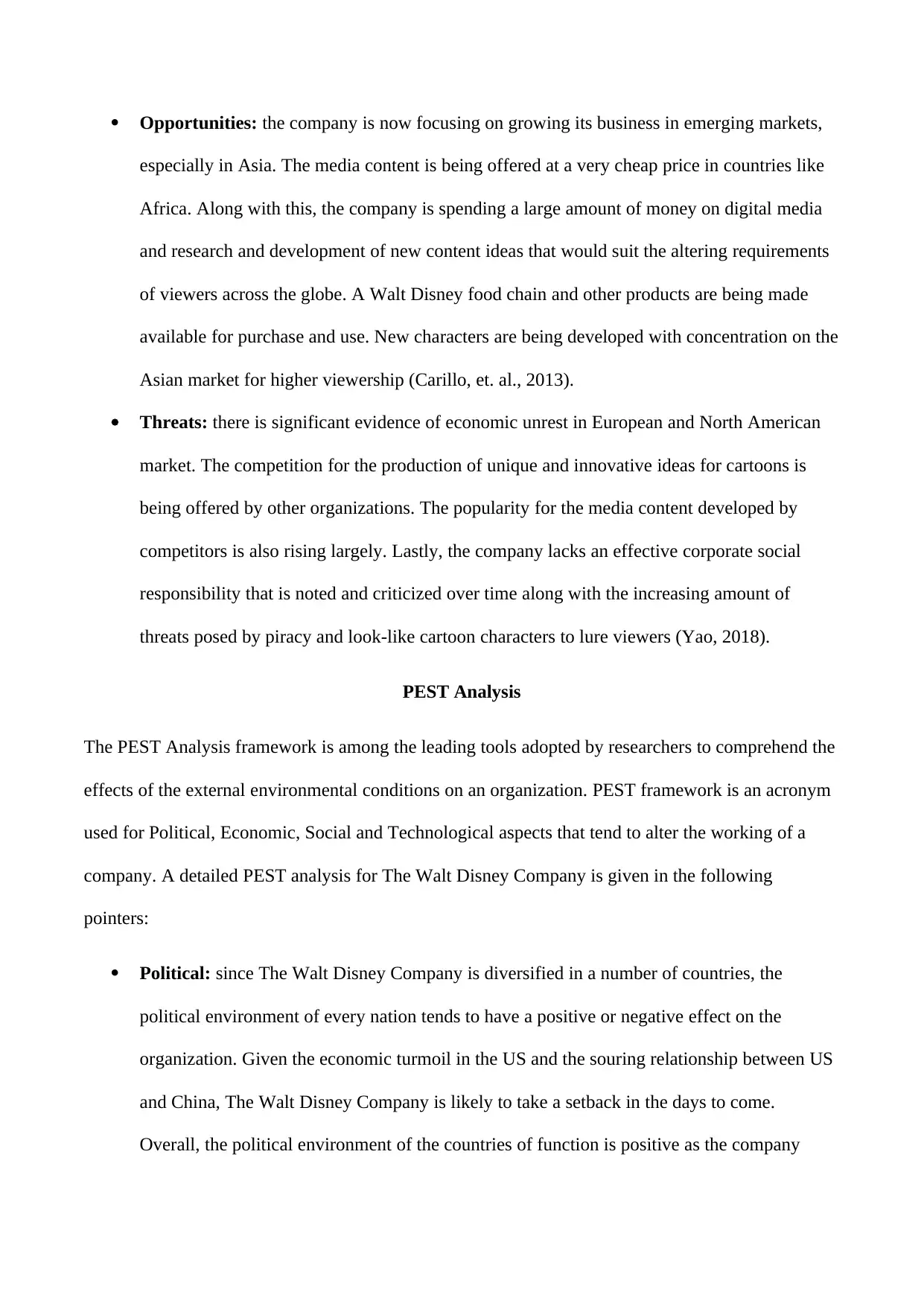
Opportunities: the company is now focusing on growing its business in emerging markets,
especially in Asia. The media content is being offered at a very cheap price in countries like
Africa. Along with this, the company is spending a large amount of money on digital media
and research and development of new content ideas that would suit the altering requirements
of viewers across the globe. A Walt Disney food chain and other products are being made
available for purchase and use. New characters are being developed with concentration on the
Asian market for higher viewership (Carillo, et. al., 2013).
Threats: there is significant evidence of economic unrest in European and North American
market. The competition for the production of unique and innovative ideas for cartoons is
being offered by other organizations. The popularity for the media content developed by
competitors is also rising largely. Lastly, the company lacks an effective corporate social
responsibility that is noted and criticized over time along with the increasing amount of
threats posed by piracy and look-like cartoon characters to lure viewers (Yao, 2018).
PEST Analysis
The PEST Analysis framework is among the leading tools adopted by researchers to comprehend the
effects of the external environmental conditions on an organization. PEST framework is an acronym
used for Political, Economic, Social and Technological aspects that tend to alter the working of a
company. A detailed PEST analysis for The Walt Disney Company is given in the following
pointers:
Political: since The Walt Disney Company is diversified in a number of countries, the
political environment of every nation tends to have a positive or negative effect on the
organization. Given the economic turmoil in the US and the souring relationship between US
and China, The Walt Disney Company is likely to take a setback in the days to come.
Overall, the political environment of the countries of function is positive as the company
especially in Asia. The media content is being offered at a very cheap price in countries like
Africa. Along with this, the company is spending a large amount of money on digital media
and research and development of new content ideas that would suit the altering requirements
of viewers across the globe. A Walt Disney food chain and other products are being made
available for purchase and use. New characters are being developed with concentration on the
Asian market for higher viewership (Carillo, et. al., 2013).
Threats: there is significant evidence of economic unrest in European and North American
market. The competition for the production of unique and innovative ideas for cartoons is
being offered by other organizations. The popularity for the media content developed by
competitors is also rising largely. Lastly, the company lacks an effective corporate social
responsibility that is noted and criticized over time along with the increasing amount of
threats posed by piracy and look-like cartoon characters to lure viewers (Yao, 2018).
PEST Analysis
The PEST Analysis framework is among the leading tools adopted by researchers to comprehend the
effects of the external environmental conditions on an organization. PEST framework is an acronym
used for Political, Economic, Social and Technological aspects that tend to alter the working of a
company. A detailed PEST analysis for The Walt Disney Company is given in the following
pointers:
Political: since The Walt Disney Company is diversified in a number of countries, the
political environment of every nation tends to have a positive or negative effect on the
organization. Given the economic turmoil in the US and the souring relationship between US
and China, The Walt Disney Company is likely to take a setback in the days to come.
Overall, the political environment of the countries of function is positive as the company
⊘ This is a preview!⊘
Do you want full access?
Subscribe today to unlock all pages.

Trusted by 1+ million students worldwide
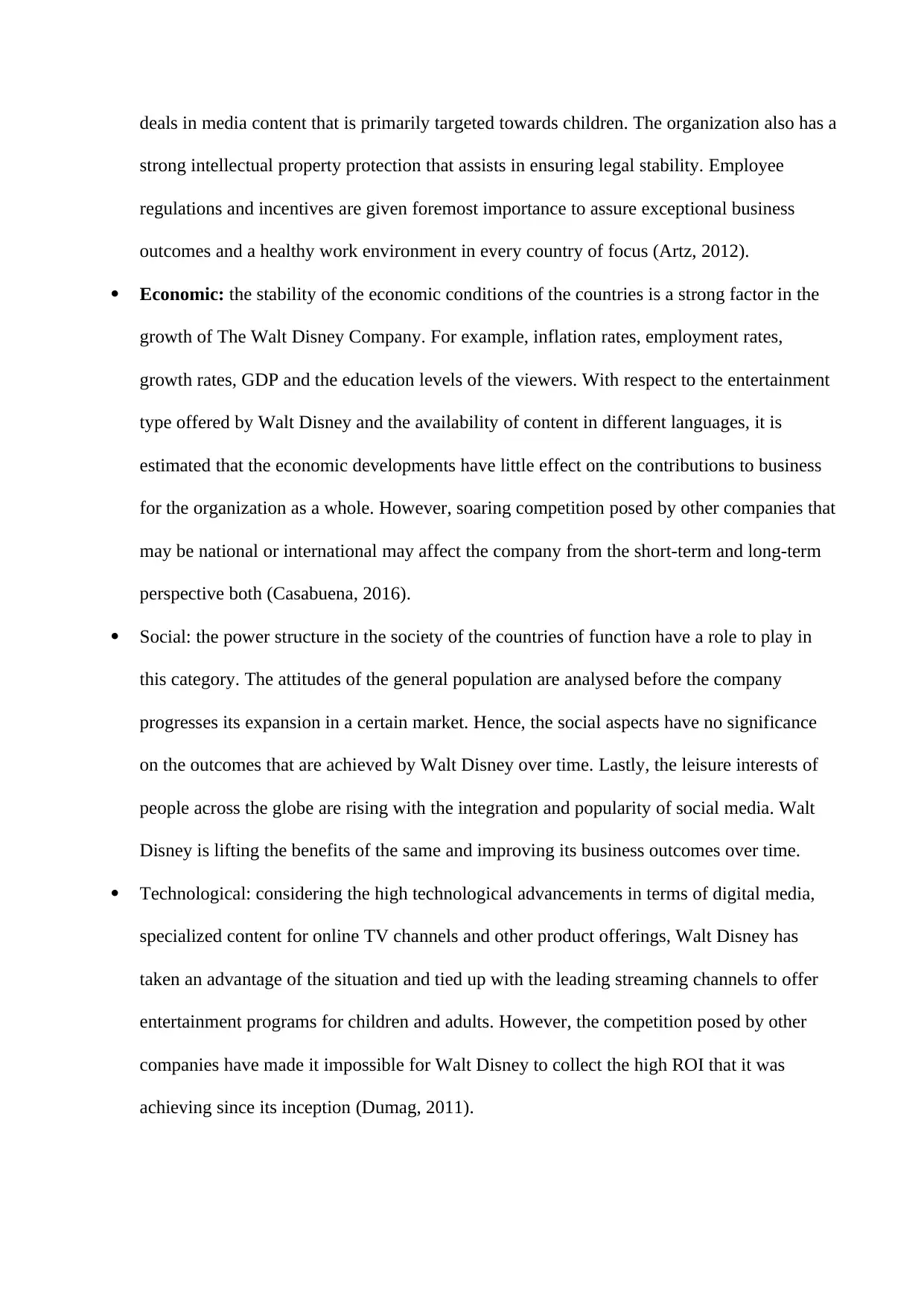
deals in media content that is primarily targeted towards children. The organization also has a
strong intellectual property protection that assists in ensuring legal stability. Employee
regulations and incentives are given foremost importance to assure exceptional business
outcomes and a healthy work environment in every country of focus (Artz, 2012).
Economic: the stability of the economic conditions of the countries is a strong factor in the
growth of The Walt Disney Company. For example, inflation rates, employment rates,
growth rates, GDP and the education levels of the viewers. With respect to the entertainment
type offered by Walt Disney and the availability of content in different languages, it is
estimated that the economic developments have little effect on the contributions to business
for the organization as a whole. However, soaring competition posed by other companies that
may be national or international may affect the company from the short-term and long-term
perspective both (Casabuena, 2016).
Social: the power structure in the society of the countries of function have a role to play in
this category. The attitudes of the general population are analysed before the company
progresses its expansion in a certain market. Hence, the social aspects have no significance
on the outcomes that are achieved by Walt Disney over time. Lastly, the leisure interests of
people across the globe are rising with the integration and popularity of social media. Walt
Disney is lifting the benefits of the same and improving its business outcomes over time.
Technological: considering the high technological advancements in terms of digital media,
specialized content for online TV channels and other product offerings, Walt Disney has
taken an advantage of the situation and tied up with the leading streaming channels to offer
entertainment programs for children and adults. However, the competition posed by other
companies have made it impossible for Walt Disney to collect the high ROI that it was
achieving since its inception (Dumag, 2011).
strong intellectual property protection that assists in ensuring legal stability. Employee
regulations and incentives are given foremost importance to assure exceptional business
outcomes and a healthy work environment in every country of focus (Artz, 2012).
Economic: the stability of the economic conditions of the countries is a strong factor in the
growth of The Walt Disney Company. For example, inflation rates, employment rates,
growth rates, GDP and the education levels of the viewers. With respect to the entertainment
type offered by Walt Disney and the availability of content in different languages, it is
estimated that the economic developments have little effect on the contributions to business
for the organization as a whole. However, soaring competition posed by other companies that
may be national or international may affect the company from the short-term and long-term
perspective both (Casabuena, 2016).
Social: the power structure in the society of the countries of function have a role to play in
this category. The attitudes of the general population are analysed before the company
progresses its expansion in a certain market. Hence, the social aspects have no significance
on the outcomes that are achieved by Walt Disney over time. Lastly, the leisure interests of
people across the globe are rising with the integration and popularity of social media. Walt
Disney is lifting the benefits of the same and improving its business outcomes over time.
Technological: considering the high technological advancements in terms of digital media,
specialized content for online TV channels and other product offerings, Walt Disney has
taken an advantage of the situation and tied up with the leading streaming channels to offer
entertainment programs for children and adults. However, the competition posed by other
companies have made it impossible for Walt Disney to collect the high ROI that it was
achieving since its inception (Dumag, 2011).
Paraphrase This Document
Need a fresh take? Get an instant paraphrase of this document with our AI Paraphraser
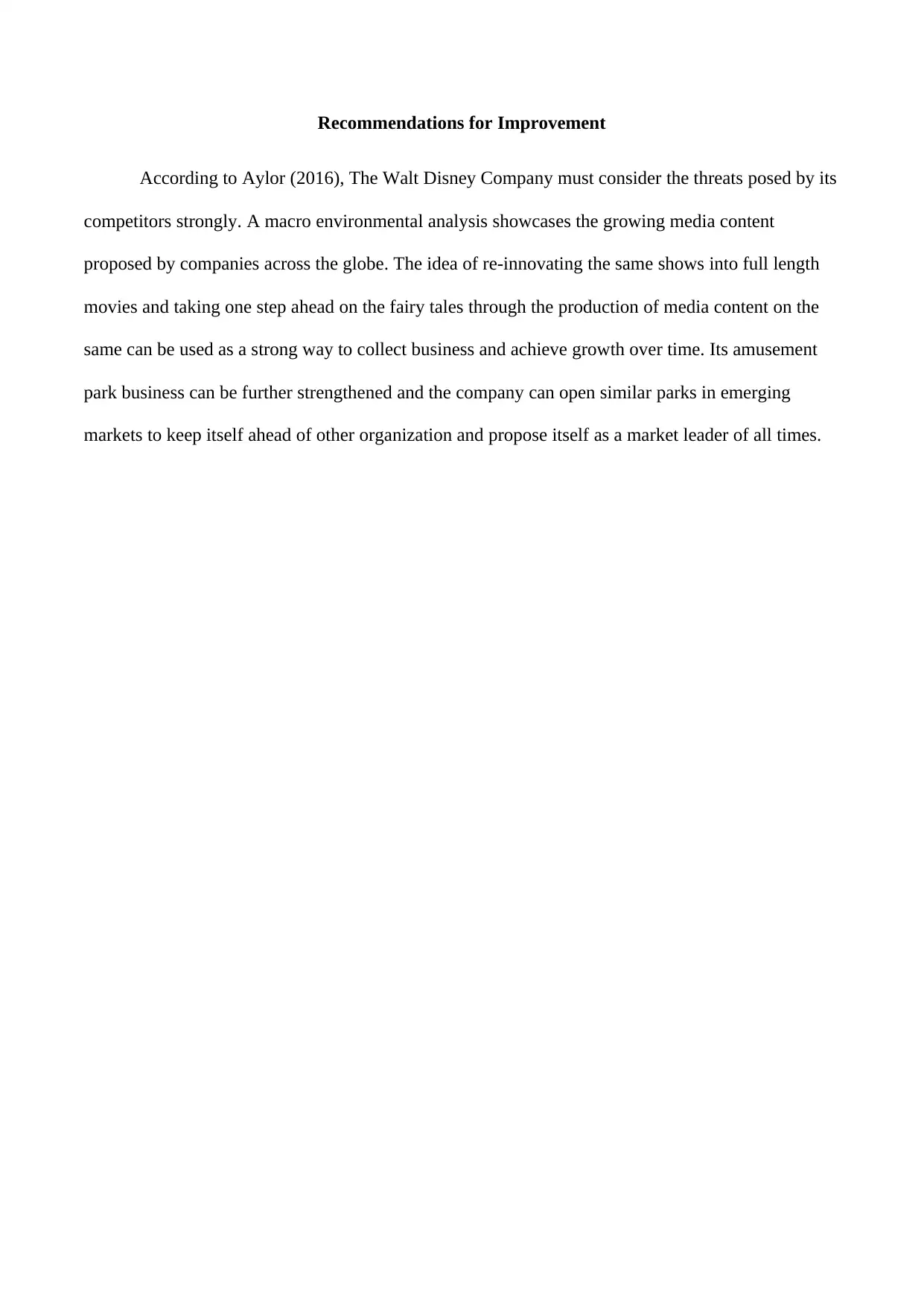
Recommendations for Improvement
According to Aylor (2016), The Walt Disney Company must consider the threats posed by its
competitors strongly. A macro environmental analysis showcases the growing media content
proposed by companies across the globe. The idea of re-innovating the same shows into full length
movies and taking one step ahead on the fairy tales through the production of media content on the
same can be used as a strong way to collect business and achieve growth over time. Its amusement
park business can be further strengthened and the company can open similar parks in emerging
markets to keep itself ahead of other organization and propose itself as a market leader of all times.
According to Aylor (2016), The Walt Disney Company must consider the threats posed by its
competitors strongly. A macro environmental analysis showcases the growing media content
proposed by companies across the globe. The idea of re-innovating the same shows into full length
movies and taking one step ahead on the fairy tales through the production of media content on the
same can be used as a strong way to collect business and achieve growth over time. Its amusement
park business can be further strengthened and the company can open similar parks in emerging
markets to keep itself ahead of other organization and propose itself as a market leader of all times.
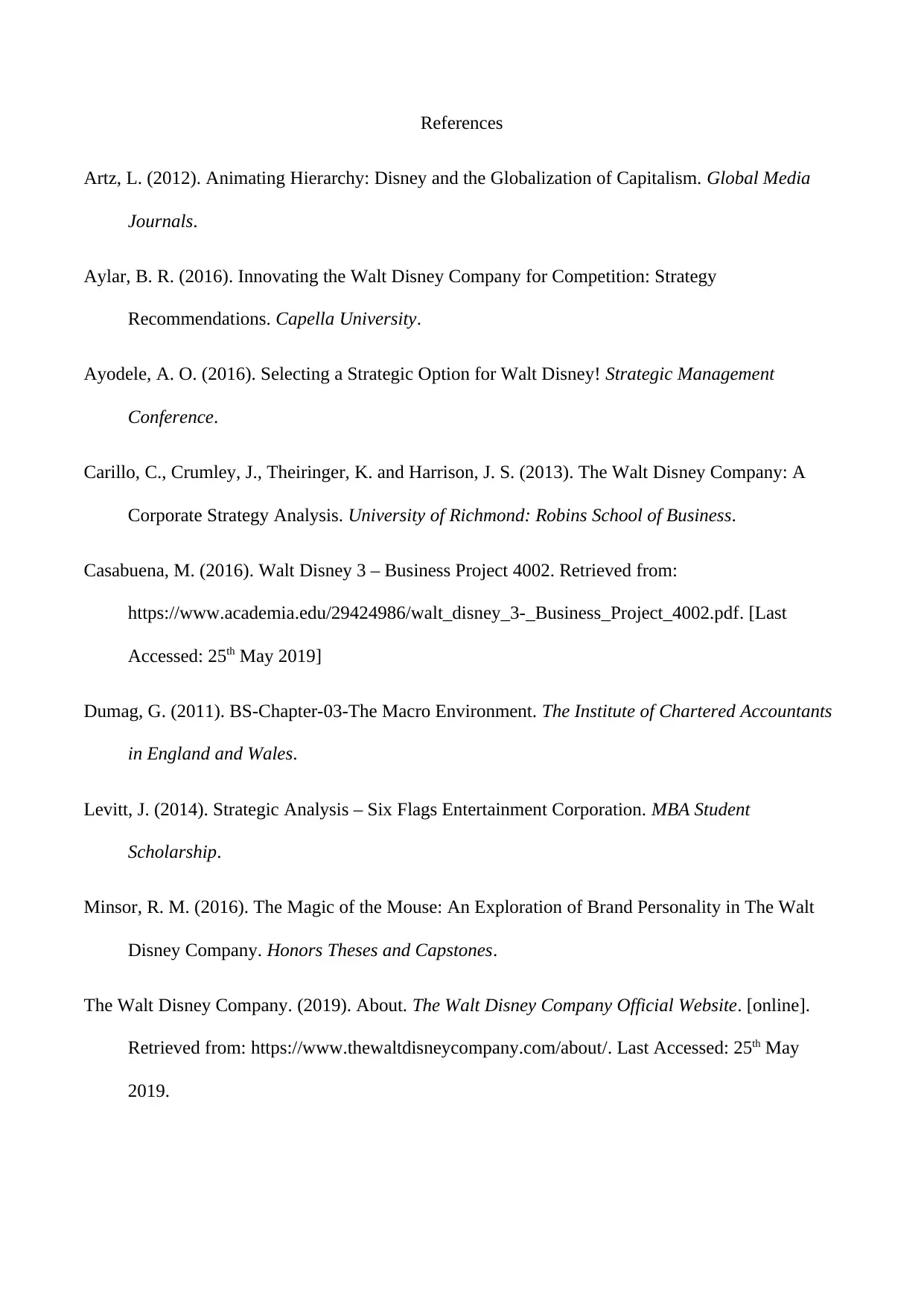
References
Artz, L. (2012). Animating Hierarchy: Disney and the Globalization of Capitalism. Global Media
Journals.
Aylar, B. R. (2016). Innovating the Walt Disney Company for Competition: Strategy
Recommendations. Capella University.
Ayodele, A. O. (2016). Selecting a Strategic Option for Walt Disney! Strategic Management
Conference.
Carillo, C., Crumley, J., Theiringer, K. and Harrison, J. S. (2013). The Walt Disney Company: A
Corporate Strategy Analysis. University of Richmond: Robins School of Business.
Casabuena, M. (2016). Walt Disney 3 – Business Project 4002. Retrieved from:
https://www.academia.edu/29424986/walt_disney_3-_Business_Project_4002.pdf. [Last
Accessed: 25th May 2019]
Dumag, G. (2011). BS-Chapter-03-The Macro Environment. The Institute of Chartered Accountants
in England and Wales.
Levitt, J. (2014). Strategic Analysis – Six Flags Entertainment Corporation. MBA Student
Scholarship.
Minsor, R. M. (2016). The Magic of the Mouse: An Exploration of Brand Personality in The Walt
Disney Company. Honors Theses and Capstones.
The Walt Disney Company. (2019). About. The Walt Disney Company Official Website. [online].
Retrieved from: https://www.thewaltdisneycompany.com/about/. Last Accessed: 25th May
2019.
Artz, L. (2012). Animating Hierarchy: Disney and the Globalization of Capitalism. Global Media
Journals.
Aylar, B. R. (2016). Innovating the Walt Disney Company for Competition: Strategy
Recommendations. Capella University.
Ayodele, A. O. (2016). Selecting a Strategic Option for Walt Disney! Strategic Management
Conference.
Carillo, C., Crumley, J., Theiringer, K. and Harrison, J. S. (2013). The Walt Disney Company: A
Corporate Strategy Analysis. University of Richmond: Robins School of Business.
Casabuena, M. (2016). Walt Disney 3 – Business Project 4002. Retrieved from:
https://www.academia.edu/29424986/walt_disney_3-_Business_Project_4002.pdf. [Last
Accessed: 25th May 2019]
Dumag, G. (2011). BS-Chapter-03-The Macro Environment. The Institute of Chartered Accountants
in England and Wales.
Levitt, J. (2014). Strategic Analysis – Six Flags Entertainment Corporation. MBA Student
Scholarship.
Minsor, R. M. (2016). The Magic of the Mouse: An Exploration of Brand Personality in The Walt
Disney Company. Honors Theses and Capstones.
The Walt Disney Company. (2019). About. The Walt Disney Company Official Website. [online].
Retrieved from: https://www.thewaltdisneycompany.com/about/. Last Accessed: 25th May
2019.
⊘ This is a preview!⊘
Do you want full access?
Subscribe today to unlock all pages.

Trusted by 1+ million students worldwide
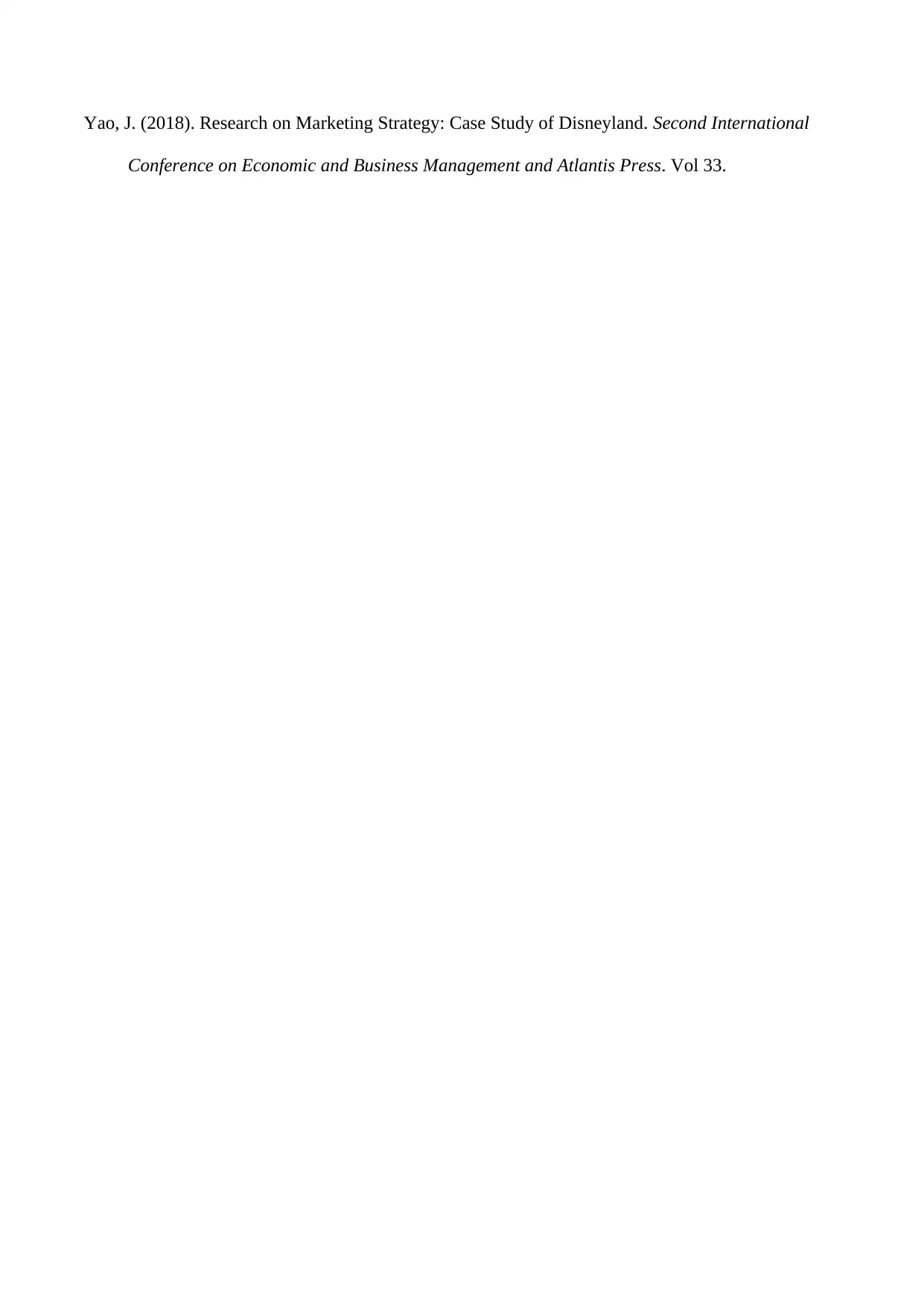
Yao, J. (2018). Research on Marketing Strategy: Case Study of Disneyland. Second International
Conference on Economic and Business Management and Atlantis Press. Vol 33.
Conference on Economic and Business Management and Atlantis Press. Vol 33.
1 out of 7
Your All-in-One AI-Powered Toolkit for Academic Success.
+13062052269
info@desklib.com
Available 24*7 on WhatsApp / Email
![[object Object]](/_next/static/media/star-bottom.7253800d.svg)
Unlock your academic potential
Copyright © 2020–2025 A2Z Services. All Rights Reserved. Developed and managed by ZUCOL.


